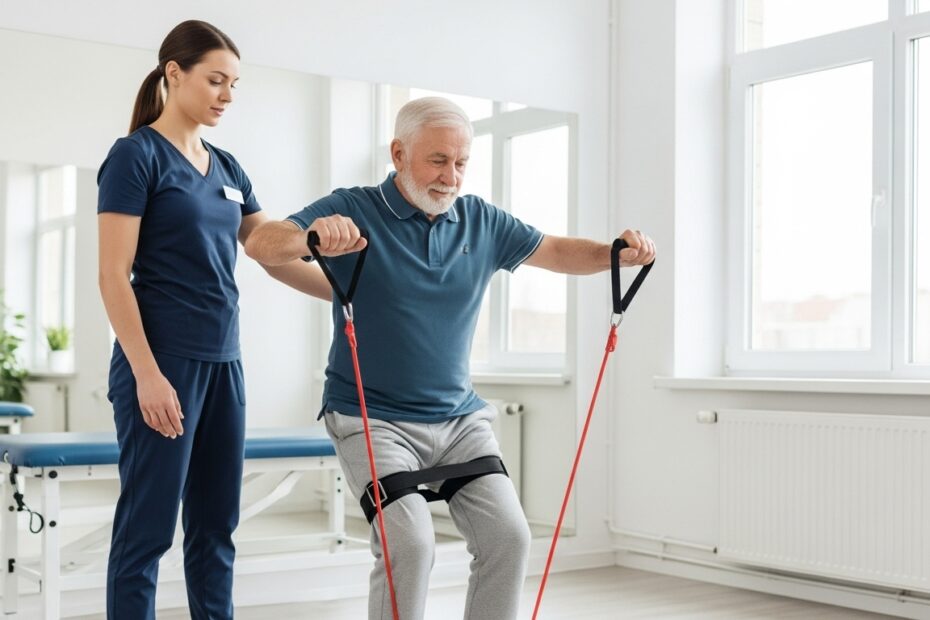Falls are the leading cause of fatal and non-fatal injuries among adults aged 65 and older.[1] They represent a serious threat to senior independence, often leading to significant injuries, a fear of falling, and a reduced quality of life.[1][2] While it’s easy to blame a fall on a single event like tripping over a rug, the truth is that most falls stem from a deeper, more complex issue.
So, what is the number one cause of falls in the elderly?
It isn’t a single condition but rather a combination of factors. However, the most critical underlying cause—the one that makes seniors most vulnerable—is difficulties with balance and walking, often stemming from lower body weakness.[3][4]
Age-related muscle loss, a condition known as sarcopenia, leads to weaker legs and a less stable core.[5] This weakness directly impairs balance and gait, making it difficult to remain steady or recover from a simple stumble that a younger person might easily overcome. The Centers for Disease Control and Prevention (CDC) consistently identifies lower body weakness and balance issues as key risk factors.[3][6]
Think of it as the foundation. When the foundation is weak, the entire structure is more susceptible to collapse. While other factors act as triggers, this core weakness is what makes the fall more likely to happen in the first place.
The Interacting Web of Fall Risk Factors
Falls rarely happen in a vacuum.[7] Instead, they are typically the result of a complex interaction between this primary cause (weakness and poor balance) and other significant contributing factors. The more risk factors a person has, the greater their chance of falling.[3]
Here are the other major causes that work in concert to increase fall risk:
1. Chronic Health Conditions:
Many diseases common in older adults directly impact stability and mobility.
- Arthritis, Parkinson’s disease, and stroke can change how a person moves, affecting their gait and reaction time.[1][8]
- Diabetes can lead to neuropathy (reduced sensation in the feet), making it hard to feel the ground properly.[1]
- Heart conditions and postural hypotension (a drop in blood pressure when standing up) can cause dizziness, lightheadedness, and even fainting.[1][5][9]
2. Vision Problems:
Age-related vision decline is a major contributor. Poor eyesight, from conditions like cataracts or macular degeneration, makes it difficult to spot hazards such as steps, clutter, or changes in flooring.[3][8][9] In fact, having poor vision can more than double a person’s risk of falling.[9]
3. Medication Side Effects:
Many seniors take multiple medications, and the side effects can be a major cause of falls.[10] Drugs that affect the brain, such as tranquilizers, sedatives, and some antidepressants, are common culprits.[3] Other medications can cause dizziness or drowsiness, directly impairing balance.[5][8] The risk of falling increases with the number of medications taken.[10]
4. Home and Environmental Hazards:
The home is where the majority of falls happen.[9] These incidents are often triggered by preventable hazards, including:
- Clutter and electrical cords in walkways.[8]
- Loose throw rugs and unsecured carpets.[8][9]
- Poor lighting, especially on stairs and in hallways.[11]
- Lack of safety features like grab bars in the bathroom and handrails on stairs.[9]
5. A Previous Fall:
One of the strongest predictors of a future fall is having fallen before.[1][10] A fall, even one that doesn’t cause injury, can lead to a “post-fall syndrome,” where a person develops a fear of falling.[7] This fear often leads to decreased activity, which in turn causes more muscle weakness and worsens balance, ironically increasing the risk of another fall.[6]
How to Address the Root Cause and Prevent Falls
Understanding that weakness and poor balance are at the heart of the problem provides a clear path for prevention.
- Talk to a Doctor: The first step is to have a fall risk assessment. A doctor can review health conditions and medications to identify specific risks.[10]
- Focus on Strength and Balance: Engage in exercises specifically designed to improve lower body strength and balance. Activities like Tai Chi are highly effective. A physical therapist can create a safe and personalized program.[5]
- Get Regular Eye and Hearing Exams: Ensure eyeglass prescriptions are up-to-date.[5] Since hearing also plays a role in balance, get it checked regularly.[4]
- Make the Home Safer: Conduct a thorough safety check of the home to remove tripping hazards, improve lighting, and install safety devices.[9]
By addressing the number one cause—weakness and balance—and mitigating the other contributing factors, seniors can dramatically reduce their risk of a debilitating fall and maintain their safety and independence for years to come.
Join Us on Youtube – Senior Recuperate
